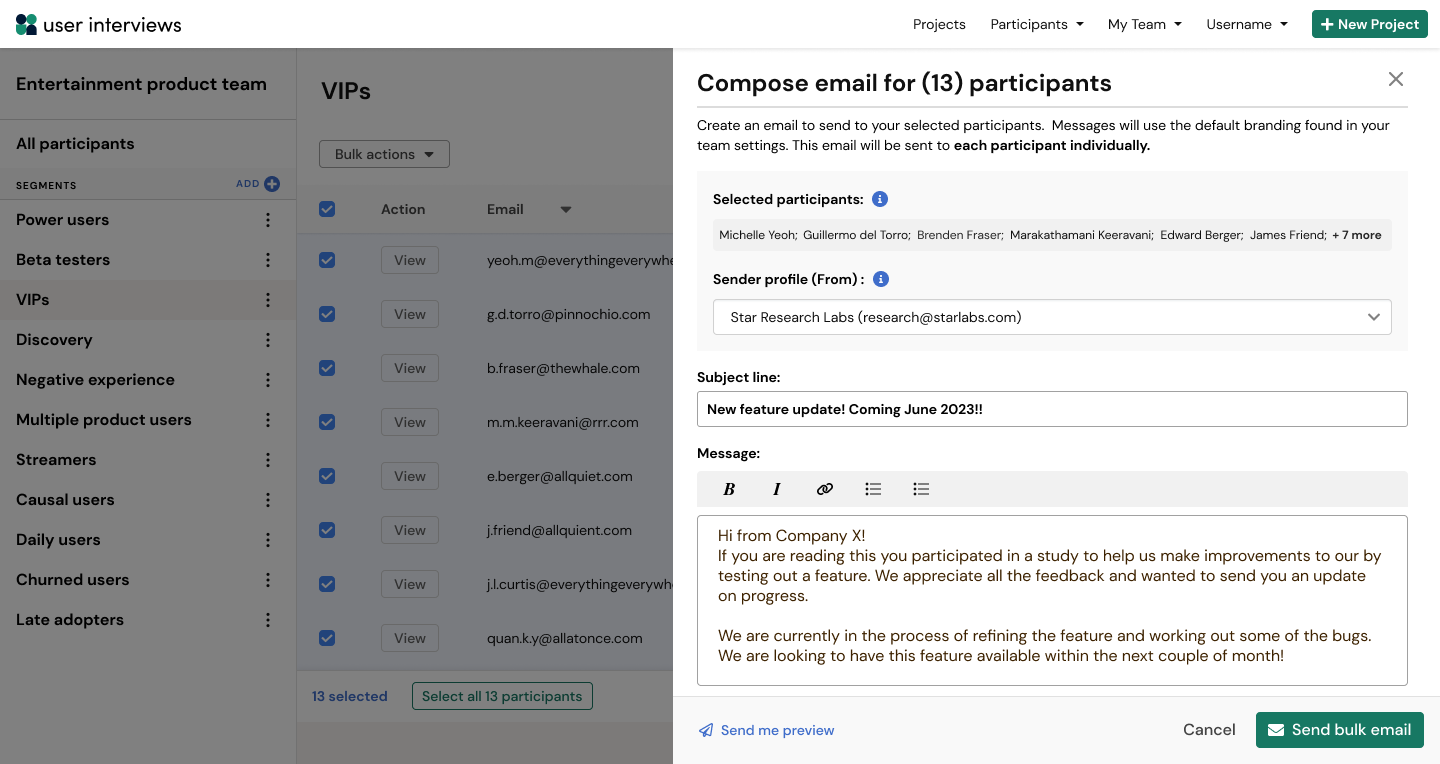Selected projects
I'm highlighting four projects; two recent with two of my all time favorites. More projects by company can be found on my Works page, where you can learn more about my process in different company environments.

Bulk Email Communications
A simple MVP email tools to enable researcher engagement with participants.


Bulk Email Communications
** Password protected** Email me for access. 🙏 Appreciate it!
Problem
Researchers were limited to study-specific messaging, making it hard to send updates, engage participants, maintain panel health, share updates, or ensure compliance. Workarounds & methods that were inefficient, error-prone, introduced external processes, friction and inconsistency.
Solution
Panel messaging that was decoupled from studies. A streamlined bulk email composer built directly into the participant management system, enabling teams to communicate with segments of their panel across studies, without the need for workarounds.
Approach
I led the end-to-end research and design for a bulk messaging feature, collaborating closely with researchers, customer success, and engineering. I identified key use cases, validated designs through testing, and ensured the experience was simple, secure, and compliant.

Outcome
The MVP filled a critical communication gap and also laid the groundwork for broader platform changes. It allowed the team to test backend decoupling between participants and studies, which helped inform future architecture decisions for more flexible relationships.

Usage Metrics and Tracking
From scattered signals to a growing insights hub for research and ops teams. WIP


Usage Metrics and Tracking
** Password protected** Email me for access. 🙏 Appreciate it!

Problem
Admins needed usage data (like number of researchers and activity, total incentives paid out, etc) but had no easy way to access it. Customer reps filled the gap by manually creating reports, often with the same info, eating up hours each week.
Solution
A scalable insights system introduced progressively—starting with small, low-lift enhancements and evolving into a centralized dashboard to surface key metrics across the platform.
Approach
Start with small wins, build toward a system.
I noticed the pattern early and started surfacing useful data through small, low-lift UI updates—even during unrelated projects.
These early wins (like tabbed views with counts by study status) laid the groundwork for a broader system.
As needs grew, I mapped out scalable solutions and led IA research to find the right home for it all. From quick wins to an MVP dashboard and helpful data support.
Outcome (So Far)

The first version of the dashboard shipped as a simplified cost and usage tracking dashboard, currently live. Its supporting admins with accessible insights and shaping how teams measure and optimize their research efforts, with the intent to grow with more helpful insights.
- Reduced support burden
- Made usage insights more accessible
- Paved the way for a centralized, scalable dashboard
- Strengthened IA for future growth

Blueprinting a Service
Streamlining USAA's authentication: Improved security, usability, and cost savings.


Blueprinting a Service
** Password protected** Email me for access. 🙏 Appreciate it!
The Problem
A rapid Multi-Factor Authentication (MFA) rollout caused user friction, exposed fractured experiences across five security channels, and a triggered a surge in support calls, creating critical security and usability gaps for USAA's 13+ million members.
The Solution
Invest in a better roll out Security and Experience strategy while addressing as many core experience usability and security gaps in the process.
The Approach
We paused to zoom out.
I co-led a cross-functional blueprinting effort to map authentication pain points, align teams, and reframe security as a service, not just a system. Through interviews and channel audits, we mapped the fragmented authentication landscape, and facilitated cross-functional workshops to align on a unified, user-centered security strategy.
We prioritized usability alongside risk, building trust with security teams and identifying quick wins and long-term fixes.

Outcome (Impact & Future Implications)
The resulting security blueprint guided user-centric improvements, projected to save millions by streamlining authentication and reducing call center volume.
- Unified strategy for future MFA rollouts
- Projected cost savings via reduced support calls
- Strategic alignment across teams
- Foundation for secure, scalable authentication vision

Redesigning Access
Simplifying USAA’s login to boost security and ease of access.


Redesigning Access
** Password protected** Email me for access. 🙏 Appreciate it!
Problem
USAA’s login experience was fragmented and unreliable. MFA enrollment was hampered by an aggressive roll out, outdated contact info, confusing flows, and frequent timeouts. Members hit dead ends, the UI lagged behind the design system, and inconsistent patterns contributed to low adoption, rising fraud risk, and heavy call center volume.
Original Experience:

Approach:
Following our Security Blueprinting Initiative, we redesigned the web login from the ground up—resolving usability issues, modernizing the backend security infrastructure, and ensuring the new experience met WCAG accessibility standards. This effort unified login flows, simplified MFA setup, and aligned design and security to support a more resilient, inclusive system
Outcomes
- A seamless, accessible, and updated logon experience
- Improved MFA enrollment and reliability
- Reduced member friction and long-term call volume
- A stronger security foundation and scalable design system patterns


